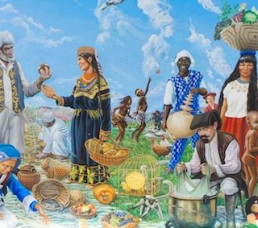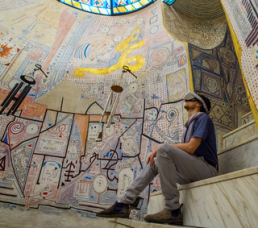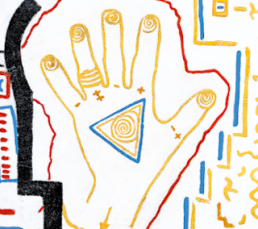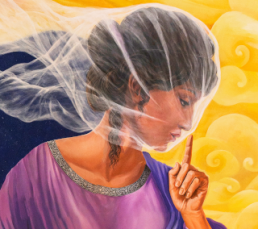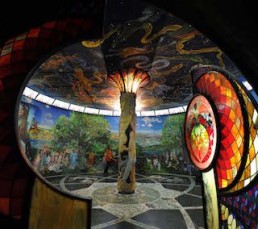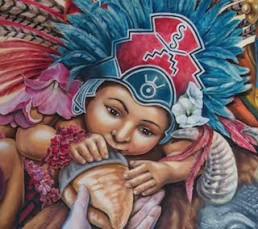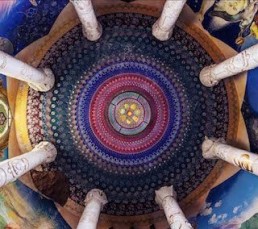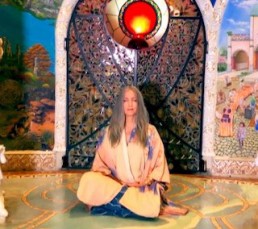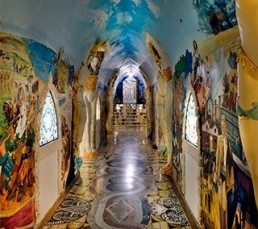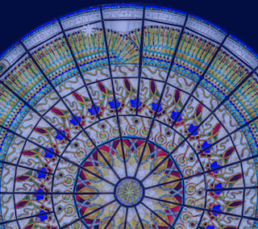Five minutes reading an exciting book or 5 minutes with your hand on a stove can feel rather different. Time interconnects with us from an observer’s perspective, so our perception is key.
During the past month here in Damanhur, we have put much thought into this very abstract yet profoundly impactful concept. We just exited the Epagomenal days, the so-called days outside of time (further in this article, you will find a link where to read more on them), and in January we experienced one specific day dedicated to Non-Time. A theatrical play running these weeks inside the underground Temples of Humankind has Time as one of the lead characters.
Falco’s teachings (on any subject, time included) were never passed down as a linear sequence of logically constructed concepts. Perceiving that channel of knowledge often required an effort to track different paths of thought, making leaps of logic, and finding traces of interconnectedness in sequences of discourses on unrelated topics. Therefore, talking about a concept as complex as time, it does not come as a surprise that he defined it in many various ways, referring to time as a physical territory, a sea, a tree, a kingdom, a dimension, an emotion, or an empire…
We invite you on this journey, meditating upon time this month.
There is a Hall inside our Temples of Humankind dedicated to Time—the Hall of Metals. Its functions are also related to Transformation, making it a perfect place to explore yourself, and specifically your body, as an alchemical laboratory, an Atanor.
Hall of Metals invites us to experience ourselves as alchemists by bringing us along the journey through different life periods to distill the best Life can offer.

Time is transformation
Eight stained-glass windows of the Hall of Metals represent eight faces reminding us of different ages, from the moment of birth to old age. Each one is connected to a metal, as a symbol of the characteristics that can support our meaningful transformation in each phase of our life. Understanding the change within that needs to happen at every step is crucial to living a complete and balanced life.
The progression from the youngest age, associated with Iron, to the oldest, corresponding to Gold, symbolizes human existence as a journey of spiritual refinement.
Each age period represents a minor reiteration of birth and death, as stepping into the following stage requires parts of us to die and new characteristics to be born. In which phase of life are you immersed right now? Did you achieve the transformation that the previous ages required?
The first window represents our first seven years of age, represented by Iron; this is when we absorb and learn from everything we see and experience. Later in life, the impactful lessons we learned at that age can be rediscovered again and again.
The second window, related to Lead, represents us at the tender age of 7-14. We begin to look beyond the comfort of our family; play and interaction with friends become our primary focus. Experimentation and playing is the dominant way to explore the world.
The third window, years 14 to 21, is represented by Sulfur, volatile and flammable, just like many of us tend to be in that age. We deny everything we had been before and strive to reinvent ourselves, demanding greater autonomy and independence.
The fourth window, Copper, is the first that lasts fourteen years and not seven, representing our stage in life from 21-35. We begin to express our talents and define who we are and what we want to become in the world; our engagement with the world becomes fully active, and we learn to contribute to the collective.
The fifth window, Mercury, reflects our ages between 35 and 49, the stage when we have gathered enough experience to transmit what we have learned to others. This is the age of self-realization when we are able not only to contribute to society but also to help shape it.
The sixth window, dedicated to Tin and years 49-65, signifies a period of stability, wisdom, pondered choices, and intense experience.
The seventh window brings us to 65-80 years and the beauty of Silver. Silver is a noble metal, gifting our human form the richness of life from a detached position, allowing us to feel the power of transition and appreciate the importance of certain things.
The last, eighth window, embodied by Gold, describes us from 80 years of age and beyond. By now, we have distilled the vital essence of life and can transmit it to those open to listening.


Time is a game of opposites.
In this journey through different life stages, moving beyond the circle of minor reincarnations, we prepare ourselves for the Great Journey to Beyond.
This life-long voyage reminds us of the importance of exercising conscious choice, exploring knowledge, and applying the power of will in transforming our negative traits into virtues, learning in circular reiterations to distill the best of ourselves to offer others.
Time invites us to meditate upon our life path; it is a tool to contact the other you in different moments, for instance, younger or older versions of yourself, to make inspired choices.
How do you see time? While making this journey through different ages, could you sense different qualities of time in your different ages? We would love to hear from you, so share with us by commenting below.
Do you want to learn more about Epagomenal days? Here is one recent article we talked about it.
Read other articles on the Temples of Humankind
Indigenous Peoples and their value in building a harmonious future
Sustainability,Spiritualità,Temples of Humankind
22 April 2022
We can build our future if we rely on our past in an adequate way. Instead of looking at the past through the history of our nations, which we are usually thought in school, you can look at it through the stories of the Peoples of our land and their traditions, and their different practical and spiritual approaches to life. This vision can provide us with useful and practical elements to create a new future.
by Damanhur Communications team
1 Comment6 Minutes
Immerse yourself in the art of the Temples
Art & creativity,Temples of Humankind,Destination Damanhur
21 September 2021
Last year I was asked to coordinate the realization of an old project, namely the creation of the Virtual Tour of the Temples. The idea of making the Temples even more accessible to the world immediately got me excited!
2 Comments6 Minutes
Hands of Light
Spiritualità,Temples of Humankind
23 November 2020
In many mystical and spiritual traditions around the world, the hand, or more precisely, the palm of the hand, has traditionally been a symbol of force and power.
by Damanhur Communications team
0 Comments4 Minutes
Divine silence
for communication
Spiritualità,Temples of Humankind
13 November 2020
Angerona, primordial goddess of the Roman region, is the protector of silence and secrets. She is an elusive, difficult to define goddess, and even artists from ancient times could not make a precise portrait of her. She was even confused with other divine figures sometimes.
by Damanhur Communications team
4 Comments7 Minutes
Why we have built
the Temples
13 April 2020
Magical and spiritual architecture is based on codes, symbols, and structural elements that receive information coming from the Synchronic Lines and spread them across the planet. Monks, druids, shamans...
by Damanhur Communications team
0 Comments5 Minutes
A child
playing with flowers
Spiritualità,Temples of Humankind
7 April 2020
There is a message from Xochipilli that we can listen to today when a virus suspends our lives, our habits, and our need to encounter others. This message is contained in the image of flowers and games. Flowers are...
by Damanhur Communications team
0 Comments7 Minutes
The Temples of Humankind and Beethoven
Art & creativity,Temples of Humankind
24 March 2020
Most of what we can hear and read about now is the pandemic. It is certainly super important to keep informed, and we also know how inspiring stories help us feel good and support a healthy immune system :-)
So, we commit to sharing content that inspires us, so that when we can finally walk freely under the sun, we will have new ideas and maybe a new worldview.
Here is a recent story that talks about the connection between Beethoven and the Temples of Humankind. Interested in discovering it? Keep on reading... :)
by Damanhur Communications team
0 Comments8 Minutes
The Temples
told by
Julie Piatt
13 February 2020
Julie Piatt — who also uses the spiritual name of Srimati — is a spiritual guide, a healer, a vegan chef, a best selling author, and a star podcaster. Srimati is also singer-songwriter with a spiritual and healing focus, and a story behind her songs...
by Damanhur Communications team
0 Comments4 Minutes
Art, soul and history
Art & creativity,Temples of Humankind
14 January 2020
In the chronicles of the time, it is clearly told that alongside the bricklayers and those who were involved in the construction of the large churches in Paris as in Rome in Madrid, in England and so on, even merchants, professionals and peasants...
by Damanhur Communications team
0 Comments6 Minutes
Happy Holidays from the Temples of Humankind
Art & creativity,Live community,Temples of Humankind
24 December 2019
May each of us be a luminous example to inspire others to do good, and lead the world towards a decade of...
by Damanhur Communications team
0 Comments2 Minutes
